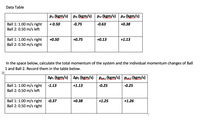Question
Based on your data, What can you conclude about the momentum changes for Balls 1 and 2 in these collisions?

Transcribed Image Text:Data Table
Pi (kgm/s)
Pzi (kgm/s)
Pit (kgm/s) Pzt (kgm/s)
Ball 1: 1.00 m/s right
Ball 2: 0.50 m/s left
+ 0.50
-0.75
-0.63
+0.38
Ball 1: 1.00 m/s right
Ball 2: 0.50 m/s right
+0.50
+0.75
+0.13
+1.13
In the space below, calculate the total momentum of the system and the individual momentum changes of Ball
1 and Ball 2. Record them in the table below.
Ap1 (kgm/s)
Ap2 (kgm/s)
Rrot,i (kgm/s) | Rrot.f (kgm/s)
Ball 1: 1.00 m/s right
Ball 2: 0.50 m/s left
-1.13
+1.13
-0.25
-0.25
Ball 1: 1.00 m/s right
Ball 2:0.50 m/s right
-0.37
+0.38
+1.25
+1.26
Expert Solution
This question has been solved!
Explore an expertly crafted, step-by-step solution for a thorough understanding of key concepts.
Step by stepSolved in 3 steps

Knowledge Booster
Similar questions
- For the same collision as above, motion sensors record the velocities as a function of time for both carts. The graph of this function for the heavier cart is this: 2 t What qualities can we expect to see for a graph of velocity vs. time coming from the motion sensor recording the lighter cart's motion during the same collision? [Note: In our lab, the motion sensors are looking at their respective carts from opposite directions, so the positive direction for one sensor is the negative direction for the other, but for the purposes of this question, we will assume that the sensors agree upon the positive direction .] O The graph goes no higher than dotted line #2. The graph crosses dotted line #2, but goes no higher than dotted line #1. The graph crosses both dotted lines. There is not enough information to determine whether the graph crosses either dotted line.arrow_forwardSuppose two steel balls are taken into Earth orbit and collide in the vacuum of One ball is initially stationary (relative to the spacecraft) and the other is given an initial velocity. Is momentum conserved in this collision? space. 1ligion an elastic collision?arrow_forwardcan you help with 8 sub parts a, b, and carrow_forward
- A basketball with a mass of 0.60 kg falls vertically to the floor where it hits with a velocity of -4 m/s. (We take the positive direction to be upward here.) The ball rebounds, leaving the floor with a velocity of 2.5 m/s. (Indicate the direction with the signs of your answers.) (a) What impulse (in kg m/s) acts on the ball during its collision with the floor? kg • m/s (b) If the ball is in contact with the floor for 0.04 s, what is the average force of the ball on the floor (in N)?arrow_forwardA 75 kg person standing on a frictionless floor fires two 100 gram bullets at 500 m/s (parallel to the ground) one right after the other out of a 3 kg gun; use conservation of momentum to calculate the recoil speed at which the person slides backwards (show all the math steps in your derivation):arrow_forwardA proton that has a mass m and is moving @ 400m/s in the +i direction undergoes a head-on elastic collision with a stationary oxygen nucleus of mass 16m. Find the velocities of the proton and the oxygen nucleaus after the collision.arrow_forward
- For all the collisions in this lab, what can you conclude about the sum of the changes in momentum for the objects (Δp1 + Δp2 for Parts 1 and 2 and Δp1 + Δp2 + Δp3 for Part 3)? Does this agree with the Law of Momentum Conservation? Show why or why not.arrow_forwardA ball of clay of mass m is thrown with a speed v against a brickwall. The clay sticks to the wall and stops. Is the principle ofconservation of momentum violated in this example?arrow_forwardIn what way can you tell if linear momentum and/or k.E are conserved in a 1D collision? Would the impulse on both objects be the same in a collision?arrow_forward
- During that Laboratory, you found that impulse could also be related to motion in a certain way. Relate that simple mathematical relationship here. You also found a relationship between pairs of forces in certain situation. restate that relationship here. put these Results together to draw a general conclusion comparing the motion of two objects before and after a collision. You should be able to find a quantity, which will remain changed in a collision. Be sure to justify your reasoning. (Images of the lab mentioned).arrow_forwardA particle of mass m (particle #1) is fired head-on at speed 48 m/s toward another particle of mass 3m (particle #2) which is at rest. The result of this collision is that #1 comes to a complete stop, and #2 moves forward. (a) At what speed does particle #2 emerge from the collision? (b) What fraction of the original kinetic energy is lost during this process?arrow_forwardCan any real collision ever be truly perfectly elastic? Why or why not? (You should think about this in two ways: first consider what effects of the environment surrounding the collision might have on energy and momentum conservation; second, consider the objects themselves – how must an object react to a collision in order to be considered "perfect"?).arrow_forward
arrow_back_ios
SEE MORE QUESTIONS
arrow_forward_ios